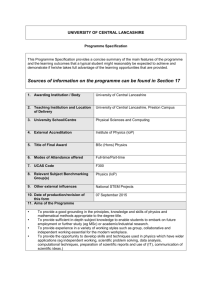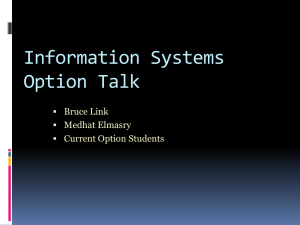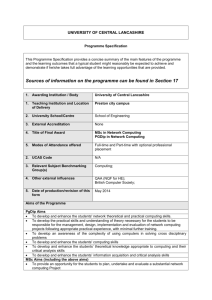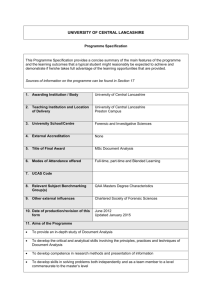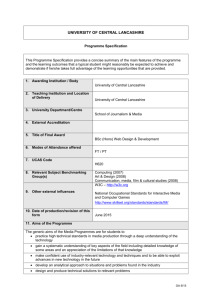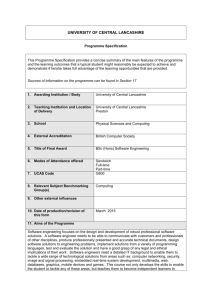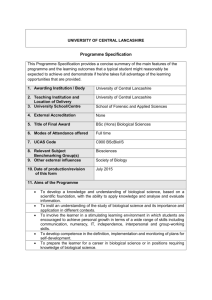course specification. - University of Central Lancashire
advertisement
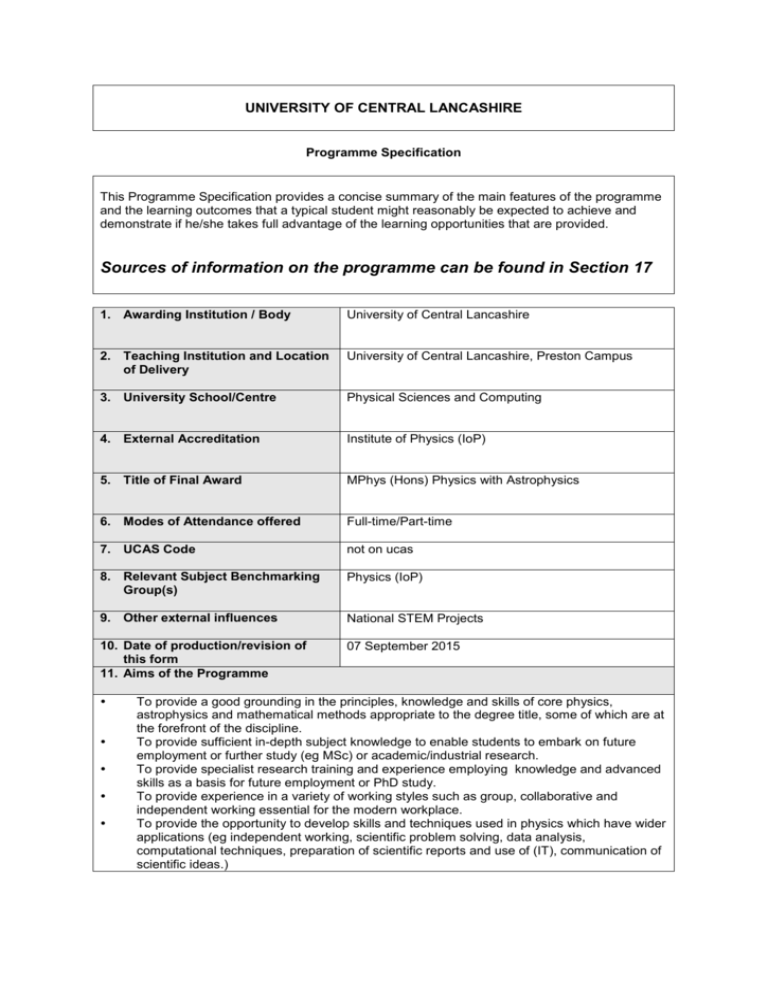
UNIVERSITY OF CENTRAL LANCASHIRE Programme Specification This Programme Specification provides a concise summary of the main features of the programme and the learning outcomes that a typical student might reasonably be expected to achieve and demonstrate if he/she takes full advantage of the learning opportunities that are provided. Sources of information on the programme can be found in Section 17 1. Awarding Institution / Body University of Central Lancashire 2. Teaching Institution and Location of Delivery University of Central Lancashire, Preston Campus 3. University School/Centre Physical Sciences and Computing 4. External Accreditation Institute of Physics (IoP) 5. Title of Final Award MPhys (Hons) Physics with Astrophysics 6. Modes of Attendance offered Full-time/Part-time 7. UCAS Code not on ucas 8. Relevant Subject Benchmarking Group(s) Physics (IoP) 9. Other external influences National STEM Projects 10. Date of production/revision of this form 11. Aims of the Programme 07 September 2015 To provide a good grounding in the principles, knowledge and skills of core physics, astrophysics and mathematical methods appropriate to the degree title, some of which are at the forefront of the discipline. To provide sufficient in-depth subject knowledge to enable students to embark on future employment or further study (eg MSc) or academic/industrial research. To provide specialist research training and experience employing knowledge and advanced skills as a basis for future employment or PhD study. To provide experience in a variety of working styles such as group, collaborative and independent working essential for the modern workplace. To provide the opportunity to develop skills and techniques used in physics which have wider applications (eg independent working, scientific problem solving, data analysis, computational techniques, preparation of scientific reports and use of (IT), communication of scientific ideas.) 12. Learning Outcomes, Teaching, Learning and Assessment Methods A. A1. A2. A3. A4. Knowledge and Understanding Describe and explain most fundamental physical laws and principles. Apply these principles to diverse areas of physics appropriate to the degree title. Use appropriate mathematical techniques to model physical systems. Discuss uncertainties and limitations of physical theory.A5. Describe, explain and apply physical principles at greater depth and mathematical rigour eg application in some areas at (or informed by) the forefront of the discipline and interpretations of mathematical descriptions of physical phenonena. Teaching and Learning Methods Lectures and laboratories supported by tutorials and seminars. Project supervision. Self-study aided by worked examples and practice problems. Feedback on assessed and unassessed work. Recommended textbooks and on-line resources. Assessment methods Examinations, assessed problem sheets, logbooks, scientific reports, seminar presentations and detailed project viva. B. Subject-specific skills B1. Solve problems in physics using appropriate mathematical techniques. B2. Use a range of laboratory apparatus and appropriate experimental techniques. B3. Apply a variety of techniques (experimental, mathematical and/or computational) to specialist areas. B4. Communicate complex scientific ideas, the conclusion of an experiment, investigation or project effectively. B5. Demonstrate a mature level of subject skills including the competent use of specialised equipment or techniques; their application to specialised areas some of which are current research topics and communicate these complex scientific ideas, the conclusions of an experiment, investigation or project accurately and informatively. Teaching and Learning Methods Tutorials, examples classes and lectures, project work, group work, computer sessions. Self-test questions and problem sheets requiring the use of mathematical techniques, calculator, PC, to solve quantitative problems. Laboratory classes with pre-laboratory preparation, research methods lectures and self-study. Feedback on assessed and unassessed work. Assessment methods Problem sheets, exams, reports and essays, project report and viva. C. Thinking Skills C1. Identify relevant principles and fundamental laws and formulate problems in precise terms. C2. Manipulate precise and intricate ideas to solve closed and open-ended problems using appropriate physical laws and mathematical techniques. C3. Plan practical/theoretical investigations using textbooks and wide range of other sources, execute the plan, critically analyse the results and evaluate their significance. C4. Construct logical arguments following a critical analysis of appropriate information sources and draw conclusions. Teaching and Learning Methods Lectures, tutorials, laboratories, workshops and project work, computer sessions, self-study. Practice problems, open-ended problems, group and collaborative work. Assessment methods Logbooks, lab and project reports, group reports, essays, seminars, problem sheets, examinations. D. Other skills relevant to employability and personal development D1. Communicate complex ideas concisely, accurately and informatively through oral and written media, using appropriate ICT. D2. Use appropriate ICT packages/systems effectively for the retrieval of appropriate information, analysis of data and modelling to the level required for extended project work. D3. Manage own learning, making optimum use of learning materials, appropriate textbooks, research articles and other primary sources. D4. Work collaboratively and as part of a group working towards a common goal. Teaching and Learning Methods Group work, formal group study meetings. Project work, laboratory classes and Miniprojects/extended experiments. Skills workshops. Seminars, project supervisory meetings, self study. Risk assessments are an integral part of the laboratory and project work. Feedback on assessed and unassessed work. Assessment methods Formal scientific reports for laboratory work and projects. MPhys project viva. Presentations. Essays, Setting and meeting deadlines (project and group study, and assessment deadline.) 13. Programme Structures Level Level 7 Level 6 Module Code AA4046 AA4047 AP4553 AP4852 Ap4870 AP4871 AP4872 MP4708 Module Title AA3010 Formation, Structure and Evolution of Stars Cosmology and Relativity Year 3 Laboratory Condensed Matter Nuclear and Particle Physics Electrodynamics and Adv Quantum Mechanics BSc (Hons) Project Partial Differential Equations and Integral Systems Fluid Dynamics 20 Ordinary Differential Equations Vector Calculus Lagrangian and Hamiltonian Mechanics Astrophysics II Electromagnetism and waves Year 2 Laboratory Scientific Computing Thermal and Quantum Physics 20 20 20 Introduction to Physics Introduction to Laboratory Physics Introduction to Astronomy Functions, Vectors & Calculus Applied Physics and Linear Systems Introduction to Mechanics 20 20 AA3053 AP3060 AP3841 AP3842 AP3843 AP3950 MA3831 MA3842 Level 5 MA2831 MA2832 MA2841 AA2001 AP2043 AP2060 AP2235 AP2858 Level 4 14. Awards and Credits AP1840 AP1011 AA1051 MA1831 AP1852 AP1841 Galaxies and Quasars Sun, Earth and Geospace MPhys Project Advanced Laboratory Magnetism Molecular Modelling Lasers and Modern Optics Renewable Energy Technology Credit rating 20 20 60 20 20 20 20 20 20 20 20 20 20 20 20 MPhys (Hons) Physics with Astrophysics Requires a total of 480 credits with a minimum of 120 credits at Level 7 or above, a minimum of 200 at level 6 or above and minimum of 360 at level 5 or above. BSc (Hons) Physics with Astrophysics Requires 360 credits including a minimum of 220 at Level 5 or above and 100 at Level 6 or above. BSc Physics with Astrophysics Requires 320 credits including a minimum of 180 at Level 5 or above and 60 at Level 6 or above. 20 20 20 20 20 20 Diploma of Higher Education in Physics Requires 240 credits including a minimum of 100 at Level 5 or above. Certificate of Higher Education Requires 120 credits at Level 4 or above. 20 20 20 20 15. Personal Development Planning Transferable skills are embedded within many modules. Students meet tutors individually in all years and the students are encouraged to engage in work experience and internships. In year 1, a seminar run by Futures introduces the facilities and careers advice that Futures offer, and gives an overview of the careers available to physics graduates. In year 2 there is another Futures seminar and invitation to individual careers appointments. In year 3 a series of seminars shared between Futures and subject specialist staff give an overview of employment and opportunities for further study, and practical advice on applications, CVs, personal statements etc. The final year project is viewed as a preparation for a future research career and research active staff advise individual students on research degrees. 16. Admissions criteria Programme Specifications include minimum entry requirements, including academic qualifications, together with appropriate experience and skills required for entry to study. These criteria may be expressed as a range rather than a specific grade. Amendments to entry requirements may have been made after these documents were published and you should consult the University’s website for the most up to date information. Students will be informed of their personal minimum entry criteria in their offer letter. To enter this programme students must have 300-320 ucas points or BBB overall from their A2 Alevel subjects to include Physics at with a minimum of grade B (A2) and Mathematics at a minimum of grade C (A2). Equivalent qualifications are accepted. Year one is a common first year and students may transfer between the courses at the end of their first year of study. 17. Key sources of information about the programme Student Handbook Module Catalogue uclan website: on-line course content and key info 18. Curriculum Skills Map Programme Learning Outcomes Module Level Code Module Title Core (C), Compulsory (COMP) or Option (O) Knowledge and understanding LEVEL 7 A1 AP4553 AP4852 AP4870 AP4871 AP4872 AA4046 AA4047 MPhys Project Advanced Laboratory Magnetism Molecular Modelling Lasers and Modern Optics Galaxies and Quasars Sun, Earth and Geospace Renewable Energy MP4708 Technology LEVEL 6 AA3010 AA3053 AP3060 AP3841 AP3842 AP3843 AP3950 MA3831 MA3842 Formation, Structure and Evolution of Stars Cosmology and Relativity Year 3 Laboratory Condensed Matter Nuclear and Particle Physics Electrodynamics & Advanced Quantum Physics Physics/Astronomy Project Partial Differential Equations And Integral Transforms Fluid Dynamics Comp Comp O O O O O Comp O O O A3 A4 A5 B1 Thinking Skills B2 B3 B4 C1 C2 C3 C4 D1 D2 D3 D4 O O Comp Comp Comp O A2 Subject-specific Skills Other skills relevant to employability and personal development 18. Curriculum Skills Map continued Programme Learning Outcomes Module Level Code Module Title Core (C), Compulsory (COMP) or Option (O) Knowledge and understanding LEVEL 5 A1 AA2001 Astrophysics II Electromagnetism and AP2043 Waves AP2060 Year 2 Laboratory AP2235 Scientific Computing AP2858 Thermal & Quantum Physics Ordinary Differential Equations Lagrangian and Hamiltonian MA2841 Mechanics LEVEL 4 MA2831 AA1051 Introduction to Astronomy AP1840 Introduction to Physics Introduction to AP1011 Laboratory Physics AP1841 Introduction to Mechanics Functions, vectors and calculus Applied Physics and Linear AP1852 Systems MA1831 A2 Comp Comp Comp O Comp Comp Comp A5 B1 B2 B3 B4 Comp Comp A4 Thinking Skills C1 C2 Comp Comp C4 D1 D2 D4 D3 C3 Comp O A3 Subject-specific Skills Other skills relevant to employability and personal development
